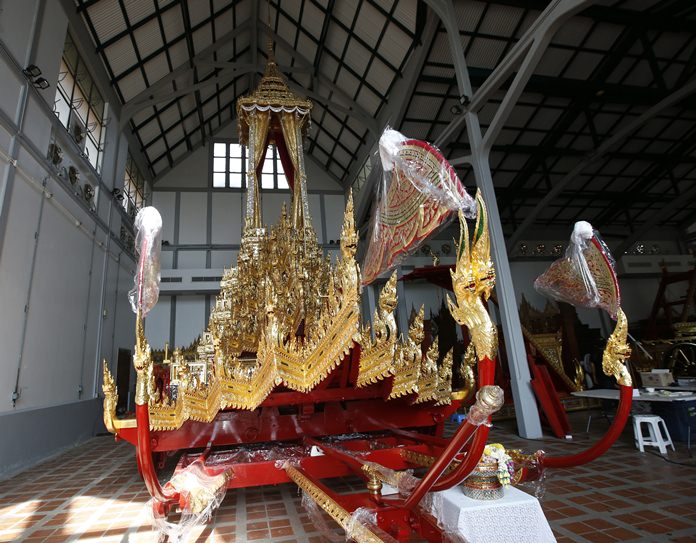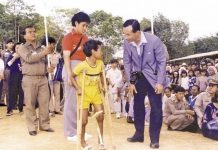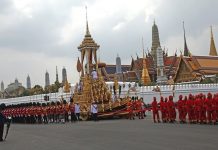
Phra Maha Phichai Ratcharot, or the Great Victory Royal Chariot, is made of carved wood, lacquered and gilded, and decorated with glass. It was built in the reign of King Rama I for the royal cremation of Somdet Phra Pathom Borommahachanok, the father of King Rama I, in 1795.
Support Pattaya Mail – Click Here
Later, it has been used to carry the royal urns of kings, queens, and members of the royal family. There is a Busabok (small pavilion) on the Phra Maha Phichai Ratcharot.
The Palanquin with Three Poles, or Phra Yannamas Sam Lam Khan (Triple Pole Royal Palanquin), was built in the reign of King Rama II for the Royal Cremation of King Rama I.
It is a large palanquin made of carved wood, gilded, and decorated with mirrors. It has a four-tiered base with modified corners on the uppermost tier, with a border plate carved and decorated with mirrors, except in the front, the back, and the jutting niches.
It is fixed to three carrying poles. On the base, a large octagonal plank is set, with four hooks ready to receive the royal urn. It is borne with three poles by two shifts of 60 strong men.
Phra Yannamas Sam Lam Khan is used to transfer the Royal Urn from Dusit Maha Prasad Throne Hall in the Grand Palace to the Great Victory Chariot. The Royal Urn is placed upon the Great Victory Chariot in front of the Elevated Royal Pavilion on the eastern side of Wat Phra Chetuphon (Wat Pho). Phra Yannamas Sam Lam Khan is 7.73 meters long and 1.78 meters high and weighs 700 kilograms.
The Royal Palanquin with Four Poles, or Rajendrayan (Palanquin with Busabok Throne), is made of carved and gilded wood, and carried on four poles by 56 strong men. The palanquin is 4.23 meters high, 5.48 meters long, and 1.03 meters wide.
The royal palanquin is used by the monarch in a grand procession known as the four-line procession, such as when the king proceeds from the royal residence in the Grand Palace to pay homage to the Emerald Buddha in the Temple of the Emerald Buddha on the occasion of the Royal Coronation Ceremony.
It is also used to transfer the royal Reliquary urn containing the royal relics of the king, the queen, or members of the royal family from the Royal Crematorium at Sanam Luang into the Grand Palace.
![Phra Yanna Mat Sam Lam Khan (“Royal Golden Palanquin[s] with Three Poles”), built during the reign of King Rama I. (Photo by Iudexvivorum via Wikipedia Commons)](https://www.pattayamail.com/wp-content/uploads/2017/10/1265-palanquin2.jpg)
Both Rajendrayan and Rajendrayan Noi are similar in style, differing primarily in size. Rajendrayan Noi is made of golden teak, with a square-shaped busabok, measuring 4.14 meters in height and one meter in width and 5.48 meters long. It is also decorated with a figure representing Thep Phanom, a celestial being with hands pressed together in prayer. This Royal Palanquin needs 56 people to carry it.





